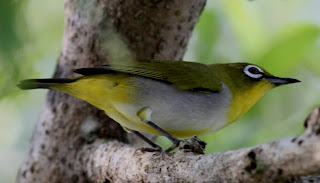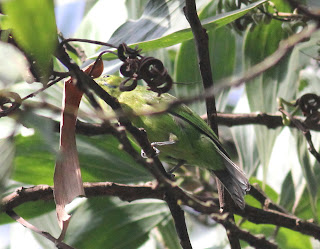Just love to see its bushy red crown.
Pecking nearby was his mate - a female Common Flameback.
These two ladies were seen squabbling over something - it could probably be over some domestic matters.
As you enter the park compound you will come across these message boards. The entrance to the trail is at the right side of the photo below.
There were ample spots and directions provided to assist you in your exploration as depicted in the image below.
The first bird seen inside the trail was this Barred Eagle Owl. This bird was not easy to be photographed not because it is an uncommon bird but it was more due to the hundreds of mozzies trying to grab me for their breakfast. This owl was seen at about 7.50am, preening itself probably after an overnight rain. Initially it was quite alert of my presence but later it went about its own business.
Look Ma no head !
As expected, there were no visiting herons or egrets except for this lone Collared Kingfisher at this time of the year.
A view from one watch tower to another.
You will not be wronged if you thought that this bird was some kind of a nuthatch.
Yup it was a Great Tit - a common resident bird at this place.
This Oriental White-Eye is also common here.
This male Ruby-cheeked Sunbird certaintly has some fantastic colors. Unfortunately my camera went out of focus at the crucial mo.
Initially i was curious on why this Pacific Swallow was on the ground instead of flying around which it would usually does. When i went thru the photo then i realised that it was actually beside an egg. Not sure how the egg got there but it must have tried to protect it. Nevertheless i did not see the bird on my way back. Hopefully i did not step on it, oops!
You can find this Ashy Tailorbird at almost every location here.
This Brahminy Kite has a rather peculiar wing shape. I guess the secondary feathers were just growing after a successful moulting.
The images above show a Changeable Hawk Eagle - immature as confirmed by the experts. Its standing posture indicates that it is ready to fly off or just perhaps getting ready to swoop down on its first prey.
Nearby the raptor i could see a female Scally-Breasted Munia feeding its chicks.
Watching closely the surrounding area was this adult scally-breasted munia.
This is another common bird at this place - a Pink-necked Green Pigeon.
This Blue-Throated Bee Eater was also seen perched instead of flying around.
Here is a lone Little Egret and a Striated Heron/Little Heron foraging nearby each other.
In addition to the birds, KSNP has a variety of crustaceans to complete its eco-system. Here are some miniature but lovely crabs or crabbies as i call them. Sounds like a famous resort area in Thailand isn't ?
I ain't no crab expert but i believe the crab with the huge claw could be a dominant male - probably a type of fiddler crabs.









































































